Moisture Transport Anomalies over the Danube River Basin during Two Drought Events: A Lagrangian Analysis
Abstract
:1. Introduction
2. Data and Method
2.1. Using SPEI-1(One-Month Standardized Precipitation Evapotranspiration Index) to Identify Meteorological Drought Events over the DRB
2.2. Lagrangian Analysis of the Anomalies in the Moisture Supply during Drought Events
3. Results and Discussion
3.1. Selection of the Meteorological Drought Events over DRB in the Period of 1980–2014
3.2. Anomalous Patterns Configured during the Drought Events in 1989–1990 and 2003
3.2.1. Drought Event in 1989/1990
3.2.2. Drought Event in 2003
3.3. Variations in the Moisture Supply from the Moisture Sources for the DRB and Meteorological Drought Conditions over the Basin during 1980–2014
4. Conclusions
Acknowledgments
Author Contributions
Conflicts of Interest
References
- Kuchment, L.S. The Hydrological Cycle and Human Impact on It. 2004. Available online: http://www.biodiversity.ru/programs/ecoservices/library/functions/water/doc/Kuchment.pdf (accessed on 10 May 2017).
- Christensen, J.H.; Christensen, O.B. Severe summertime flooding in Europe. Nature 2003, 421, 805–806. [Google Scholar] [CrossRef] [PubMed]
- Schär, C.; Vidale, P.L.; Lüthi, D.C.; Frei, C.; Häberli, C.; Liniger, M.A.; Appenzeller, C. The role of increasing temperature variability in European summer heatwaves. Nature 2004, 427, 332–336. [Google Scholar] [CrossRef] [PubMed]
- Nikolova, N.; Vassilev, S. Variability of summer-time precipitation in Danube plain, Bulgaria. J. Geogr. Inst. “Jovan Cvijic” SASA 2005, 54, 19–32. [Google Scholar] [CrossRef]
- García-Ruiz, J.M.; López-Moreno, J.I.; Vicente-Serrano, S.M.; Lasanta-Martínez, T.; Beguería, S. Mediterranean water resources in a global change scenario. Earth. Sci. Rev. 2011, 105, 121–139. [Google Scholar] [CrossRef] [Green Version]
- Bates, B.C.; Kundzewicz, Z.W.; Wu, S.; Palutikof, J.P. Technical Paper of the Intergovernmental Panel on Climate Change: Climate Change Water. 2008. Available online: https://www.ipcc.ch/pdf/technical-papers/climate-change-water-en.pdf (accessed on 10 May 2017).
- Ciric, D.; Stojanovic, M.; Drumond, A.; Nieto, R.; Gimeno, L. Tracking the Origin of Moisture over the Danube River Basin Using a Lagrangian Approach. Atmosphere 2016, 7, 162. [Google Scholar] [CrossRef]
- Gibson, J.J.; Aggarwal, P.; Hogan, J.; Herczeg, A. Isotope studies in large river basins: A new global research focus. Eos, Trans. Am. Geophys. Union 2002, 83, 613–617. [Google Scholar] [CrossRef]
- Stagl, C.J.; Hattermann, F.F. Impacts of climate change on the hydrological regime of the Danube River and its tributaries using an ensemble of climate scenarios. Water 2015, 7, 6139–6172. [Google Scholar] [CrossRef]
- Rîmbu, N.; Boroneanţ, C.; Buţă, C.; Dima, M. Decadal variability of the Danube river flow in the lower basin and its relation with the North Atlantic Oscillation. Int. J. Climatol. 2002, 22, 1169–1179. [Google Scholar] [CrossRef]
- Pistocchi, A.; Beck, H.; Bisselink, B.; Gelati, E.; Lavalle, C.; Feher, J. Water Scenarios for the Danube River Basin: Elements for the Assessment of the Danube Agriculture-Energy-Water Nexus. 2015. Available online: https://ec.europa.eu/jrc/en/publication/water-scenarios-danube-river-basin-elements-assessment-danube-agriculture-energy-water-nexus (accessed on 10 May 2017).
- Mishra, A.K.; Singh, V.P. A review of drought concepts. J. Hydrol. 2010, 391, 202–216. [Google Scholar] [CrossRef]
- Popova, Z. Drought vulnerability estimated based on crop-yield models. In Drought Management Centre for South-East Europe -DMCSEE—Summary of Project Results; Slovenian Environmental Agency: Ljubljana, Slovenia, 2012; pp. 39–54. [Google Scholar] [CrossRef]
- Seneviratne, S.I.; Lüthi, D.; Litschi, M.; Schär, C. Land-atmosphere coupling and climate change in Europe. Nature 2006, 443, 205–209. [Google Scholar] [CrossRef] [PubMed]
- Drumond, A.; Nieto, R.; Hernández, E.; Gimeno, L. A Lagrangian analysis of the variation in moisture sources related to drier and wetter conditions in regions around the Mediterranean basin. Nat. Hazards Earth Sys. Sci. 2011, 11, 2307–2320. [Google Scholar] [CrossRef] [Green Version]
- Gómez-Hernández, M.; Drumond, A.; Gimeno, L.; Garcia-Herrera, R. Variability of moisture sources in the Mediterranean region during the period 1980–2000. Water Resour. Res. 2013, 49, 6781–6794. [Google Scholar] [CrossRef] [Green Version]
- Sodemann, H.; Zubler, E. Seasonal and inter-annual variability of the moisture sources for Alpine precipitation during 1995–2002. Int. J. Climatol. 2010, 30, 947–961. [Google Scholar] [CrossRef]
- Vicente-Serrano, S.M.; Begueria, S.; Lopez-Moreno, A.J. A multiscalar drought index sensitive to global warming: The standardized precipitation evapotranspiration index. J. Clim. 2010, 23, 1696–1718. [Google Scholar] [CrossRef]
- Stohl, A.; James, P. A Lagrangian Analysis of the Atmospheric Branch of the Global Water Cycle. Part I: Method Description, Validation, and Demonstration for the August 2002 Flooding in Central Europe. J. Hydrometeorol. 2004, 5, 656–678. [Google Scholar] [CrossRef]
- Stohl, A.; James, P. A Lagrangian analysis of the atmospheric branch of the global water cycle: Part II: Moisture Transports between Earth’s Ocean Basins and River Catchments. J. Hydrometeorol. 2005, 6, 948–961. [Google Scholar] [CrossRef]
- World Meteorological Organization. Drought Monitoring and Early Warning: Concepts, Progress and Future Challenges. 2006. Available online: http://www.wamis.org/agm/pubs/brochures/WMO1006e.pdf (accessed on 11 May 2017).
- Wilhite, D.A.; Glantz, M.H. Understanding the Drought Phenomenon: The Role of Definitions. Water Int. 1985, 10, 111–120. [Google Scholar] [CrossRef]
- Panu, U.S.; Sharma, T.C. Challenges in drought research: Some perspectives and future directions. Hydrol. Sci. J. 2002, 47, S19–S30. [Google Scholar] [CrossRef]
- Urama, K.C.; Ozor, N. Impacts of Climate Change on Water Resources in Africa: The Role of Adaptation. African Technology Policy Studies Network (ATPS), 2010. Available online: http://www.ourplanet.com/climate-adaptation/Urama_Ozorv.pdf (accessed on 11 May 2017).
- Dai, A. Drought under global warming: A review. WIREs Clim. Chang. 2010, 2, 45–65. [Google Scholar] [CrossRef]
- Zlatanovic, N.; Stojkovic, M. Assessment and monitoring of droughts in Southeastern Europe: A Review. Water Res. Man. 2016, 6, 11–18. [Google Scholar]
- Spinoni, J.; Naumann, G.; Vogt, J.; Barbosa, P. Meteorological Droughts in Europe: Events and Impacts: Past Trends and Future Projections. 2016. Available online: http://www.droughtmanagement.info/literature/EC-JRC_Report%20on%20Droughts%20in%20Europe_2016.pdf (accessed on 15 September 2017).
- Rahmat, S.N. Methodology for Development of Drought Severity-Duration-Frequency (SDF) Curves. Ph.D. Thesis, RMIT University, Melbourne, Australia, 28 August 2014. [Google Scholar]
- Palmer, W.C. Meteorological Drought. 1965. Available online: https://www.ncdc.noaa.gov/temp-and-precip/drought/docs/palmer.pdf (accessed on 11 May 2017).
- World Meteorological Organization. Standardized Precipitation Index User Guide. 2012. Available online: http://www.wamis.org/agm/pubs/SPI/WMO_1090_EN.pdf (accessed on 15 September 2017).
- Vicente-Serrano, S.M.; Gouveira, C.; Camarero, J.J.; BeguerÌa, S.; Trigo, R.; LÛpezMoreno, J.I.; Azorin-Molina, C.; Pasho, E.; Lorenzo-Lacruz, J.; Revuelto, J.; et al. Drought Impacts on Vegetation Activity, Growth and Primary Production in Humid and Arid Ecosystems. 2012. Available online: http://digital.csic.es/bitstream/10261/62153/1/BegueriaS_Drought_ComCongSal-AEC_2012.pdf (accessed on 11 May 2017).
- Begueria, S.; Vicente-Serrano, S.M.; Reig, F.; Latorre, B. Standardized precipitation evapotranspiracion index (SPEI) revisted: Parameter fitting, evapotranspiration models, tools, datasets and drought monitoring. Int. J. Climatol. 2013, 34, 3001–3023. [Google Scholar] [CrossRef]
- Potop, V.; Boroneanţ, C.; Možný, M.; Štěpánek, P.; Skalák, P. Observed spatiotemporal characteristics of drought on various time scales over the Czech Republic. Theor. Appl. Climatol. 2014, 115, 563–581. [Google Scholar] [CrossRef]
- Liu, Z.; Lu, G.; He, H.; Wu, Z.; He, J. Anomalous Features of Water Vapor Transport during Severe Summer and Early Fall Droughts in Southwest China. Water 2017, 9, 244. [Google Scholar] [CrossRef]
- Harris, I.; Jones, P.D.; Osborn, T.J.; Lister, D.H. Updated high-resolution grids of monthly climatic observations—The CRU TS3.10 Dataset. Int. J. Climatol. 2014, 34, 623–642. [Google Scholar] [CrossRef] [Green Version]
- McKee, T.B.; Doesken, N.J.; Kleist, J. The relationship of drought frequency and duration to time scales. In Proceedings of the Eighth Conference on Applied Climatology, Anaheim, CA, USA, 17–22 January 1993; pp. 179–184. [Google Scholar]
- Tan, C.; Yang, J.; Li, M. Temporal-Spatial Variation of Drought Indicated by SPI and SPEI in Ningxia Hui Autonomous Region, China. Atmosphere 2015, 6, 1399–1421. [Google Scholar] [CrossRef]
- Spinoni, J.; Naumann, G.; Carrao, H.; Barbosa, P.; Vogt, J. World drought frequency, duration, and severity for 1951–2010. Int. J. Climatol. 2014, 34, 2792–2804. [Google Scholar] [CrossRef]
- Dee, D.P.; Uppala, S.M.; Simmons, A.J.; Berrisford, P.; Poli, P.; Kobayashi, S.; Andrae, U.; Balmaseda, M.A.; Balsamo, G.; Bauer, P.; et al. The ERA-Interim reanalysis: Configuration and performance of the data assimilation system. Q. J. R. Meteorol. Soc. 2001, 137, 553–597. [Google Scholar] [CrossRef]
- Trenberth, K.E.; Fasullo, J.T.; Mackaro, J. Atmospheric moisture transports from ocean to land and global energy flows in reanalyses. J. Clim. 2011, 24, 4907–4924. [Google Scholar] [CrossRef]
- Lorenz, C.; Kunstmann, H. The hydrological cycle in three state-of-the-art reanalyses: Intercomparison and performance analysis. J. Hydrometeorol. 2012, 13, 1397–1420. [Google Scholar] [CrossRef]
- Gimeno, L.; Stohl, A.; Trigo, R.M.; Dominguez, F.; Yoshimura, K.; Yu, L.; Drumond, A.; Duran-Quesada, A.M.; Nieto, R. Oceanic and terrestrial sources of continental precipitation. Rev. Geophys. 2012, 50, 1–41. [Google Scholar] [CrossRef]
- Nieto, R.; Gallego, D.; Trigo, R.M.; Ribera, P.; Gimeno, L. Dynamic identification of moisture sources in the Orinoco basin in equatorial South America. Hydrol. Sci. J. 2008, 53, 602–617. [Google Scholar] [CrossRef]
- Drumond, A.; Nieto, R.; Gimeno, L.; Ambrizzi, T. A Lagrangian identification of major sources of moisture over Central Brazil and La Plata Basin. J. Geophys. Res. Atmos. 2008, 113. [Google Scholar] [CrossRef]
- Huang, Y.; Cui, X. Moisture sources of an extreme precipitation event in Sichuan, China, based on the Lagrangian method. Atmos. Sci. Lett. 2015, 16, 177–183. [Google Scholar] [CrossRef]
- Viste, E.; Sorteberg, A. The effect of moisture transport variability on Ethiopian summer precipitation. Int J. Climatol. 2012, 33, 3106–3123. [Google Scholar] [CrossRef] [Green Version]
- Stohl, A.; Forster, C.; Sodemann, H. Remote sources of water vapor forming precipitation on the Norwegian west coast at 60° N—A tale of hurricanes and an atmospheric river. J. Geophys. Res. Atmos. 2008, 113. [Google Scholar] [CrossRef]
- Numaguti, A. Origin and recycling processes of precipitating water over the Eurasian continent: Experiments using an atmospheric general circulation model. J. Geophys. Res. Atmos. 1999, 104, 1957–1972. [Google Scholar] [CrossRef]
- Vázquez, M.; Nieto, R.; Drumond, A.; Gimeno, L. Extreme Sea Ice Loss over the Arctic: An Analysis Based on Anomalous Moisture Transport. Atmosphere 2017, 8, 32. [Google Scholar] [CrossRef]
- Spinoni, J.; Naumann, G.; Vogt, V.V.; Barbosa, P. The biggest drought events in Europe from 1950–2012. J. Hydrol. 2015, 3, 509–524. [Google Scholar] [CrossRef]
- Tselepidaki, I.; Zarifis, B.; Asimakopoulos, D.N. Low precipitation over Greece during 1989–1990. Theor. Appl. Climatol. 1992, 46, 115–121. [Google Scholar] [CrossRef]
- Tsakiris, G.; Vangelis, H. Establishing a drought index incorporating evapotranspiration. Eur. Water 2005, 9, 3–11. [Google Scholar]
- Drumond, A.; Gimeno, L.; Nieto, R.; Trigo, R.M.; Vicente-Serrano, S.M. Drought episodes in the climatological sinks of the Mediterranean moisture source: The role of moisture transport. Global Planet. Change 2017, 151, 4–14. [Google Scholar] [CrossRef]
- Barnston, A.G.; Livezey, R.E. Classification, seasonality and persistence of low-frequency atmospheric circulation patterns. Mon. Wea. Rev. 1987, 115, 1083–1126. [Google Scholar] [CrossRef]
- Trigo, R.; Xoplaki, E.; Zorita, E.; Luterbacher, J.; Kricak, S.O.; Albert, P.; Jacobeit, J.; Sáenz, J.; Fernández, J.; Glonzález-Rouco, F.; et al. Relations between Variability in the Mediterranean Region and Mid-latitude Variability. Dev. Earth Environ. Sci. 2006, 4, 179–226. [Google Scholar]
- Fink, A.H.; Brücher, T.; Krüger, A.; Leckebusch, G.C.; Pinto, J.G.; Ulbrich, U. The 2003 European summer heatwaves and drought-synoptic diagnosis and impacts. Weather 2004, 59, 209–216. [Google Scholar] [CrossRef] [Green Version]
- Ciais, P.; Reichstein, M.; Viovy, N.; Granier, A.; Ogée, J.; Allard, V.; Aubinet, M.; Buchmann, N.; Bernhofer, C.; Carrara, A.; et al. Europe-wide reduction in primary productivity caused by the heat and drought in 2003. Nature 2005, 437, 529–533. [Google Scholar] [CrossRef] [PubMed]
- Rebetez, M.; Mayer, H.; Dupont, O.; Schindler, D.; Gartner, K.; Kropp, J.P.; Menzel, A. Heat and drought 2003 in Europe: A climate synthesis. Ann. For. Sci. 2006, 63, 569–577. [Google Scholar] [CrossRef]
- Chase, T.N.; Wolter, K.; Pielke, R.A.; Rasool, I. Was the 2003 European heat wave unusual in a global context? Geophys. Res. Lett. 2006, 33. [Google Scholar] [CrossRef]
- Wolter, K.; Baldi, M.; Chase, T.N.; Otterman, J.; Pielke, R.A.; Rasool, I. Possible Causes of the South-Central European Heat Wave of 2003 a Diagnostic Perspective. 2005. Available online: https://meetings.copernicus.org/www.cosis.net/abstracts/EGU05/10447/EGU05-J-10447.pdf (accessed on 17 September 2017).

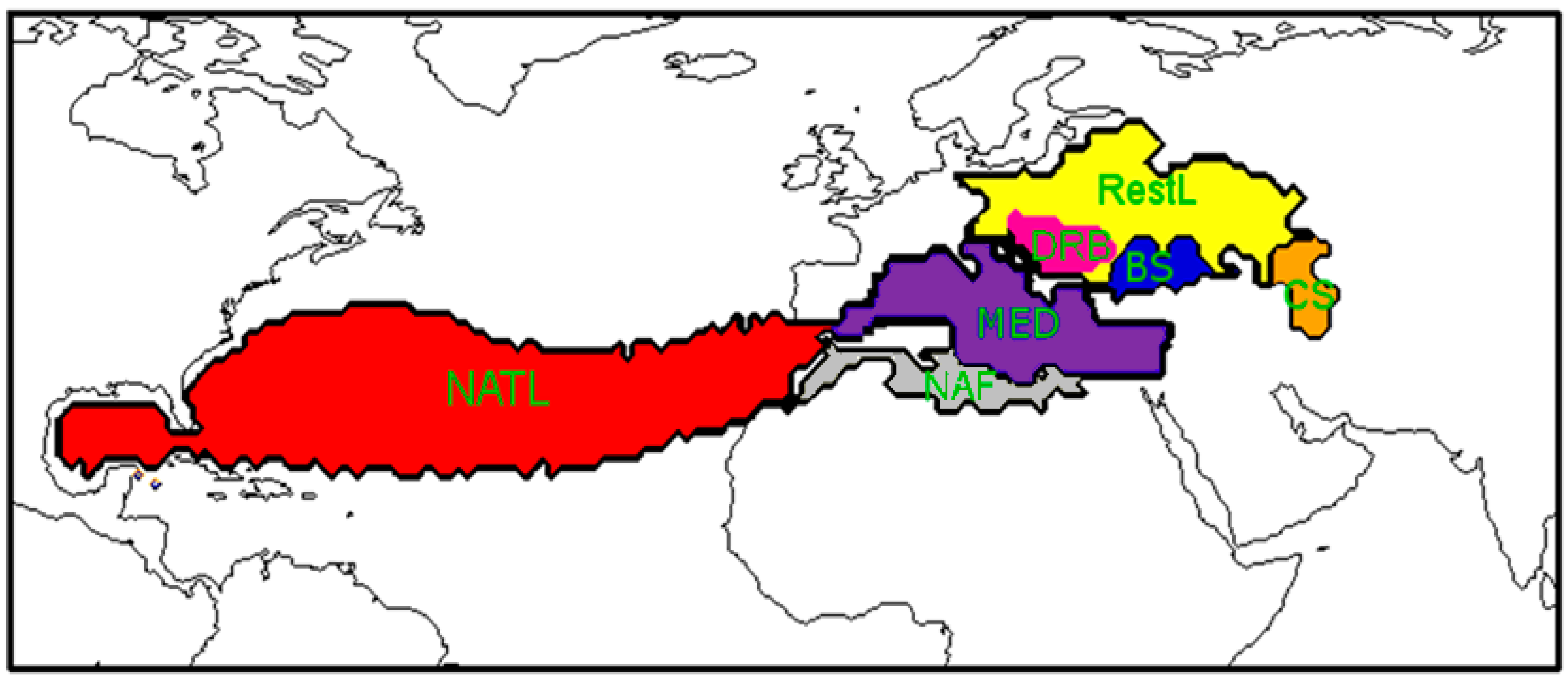
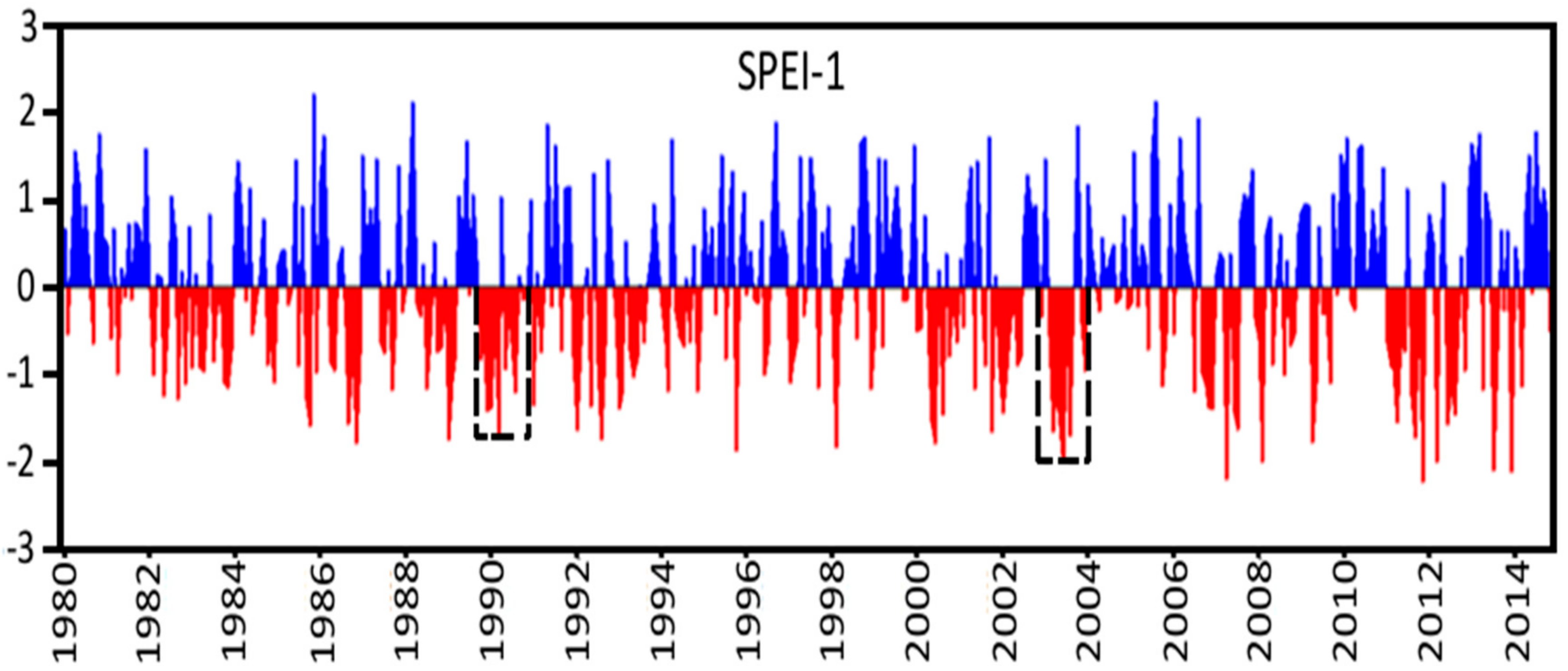
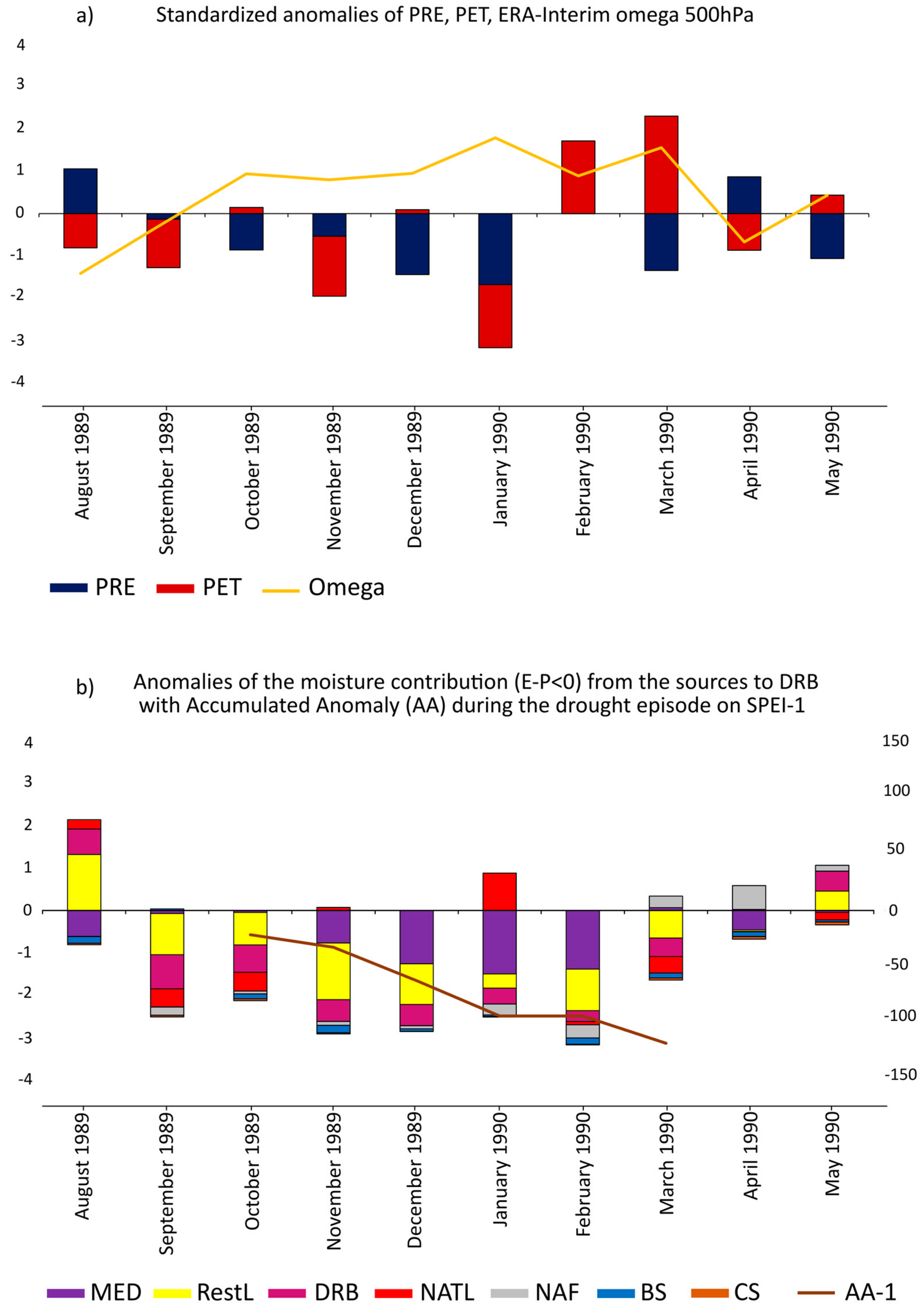

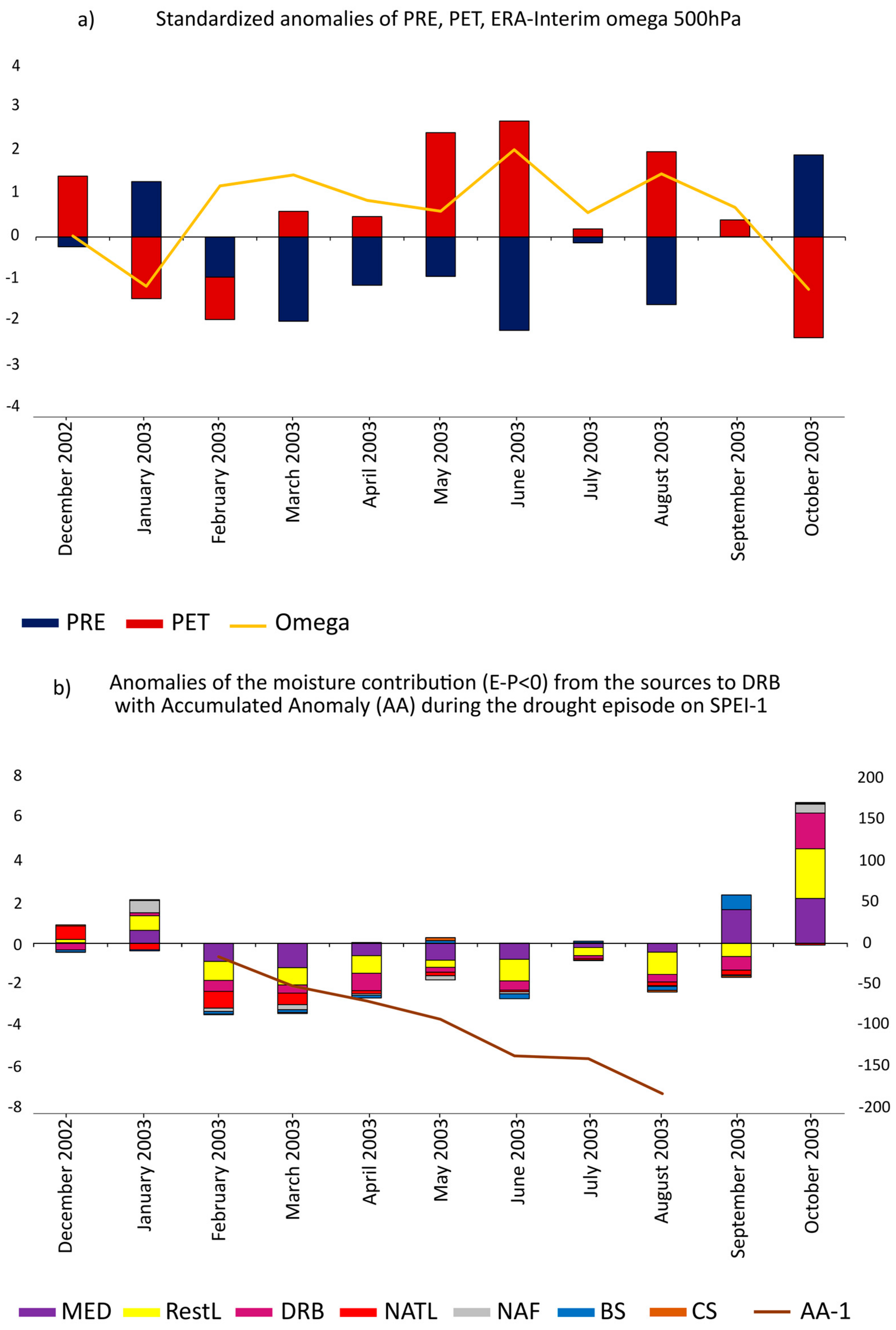
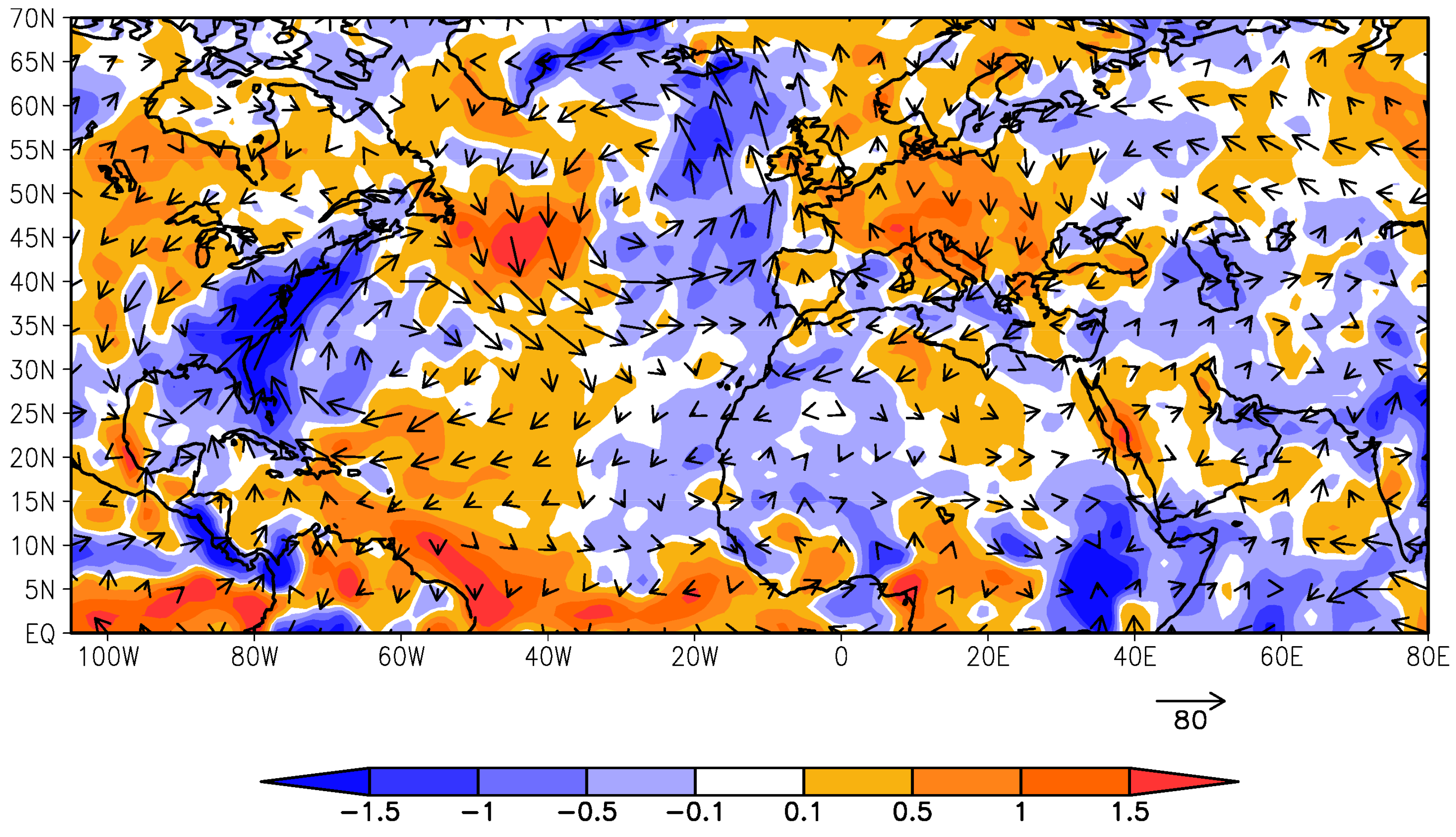
| SPEI Values | Drought Category |
|---|---|
| 0; −0.99 | Mild |
| −1.00; −1.49 | Moderate |
| −1.50; −1.99 | Severe |
| ≤−2.0 | Extreme |
| Five Most Severe Drought Episodes Occurring on SPEI-1 | Severity | Duration | Intensity | Peak Month of Each Episode |
|---|---|---|---|---|
| February 2003–August 2003 | 8.80 | 7 | 1.25 | June 2003 −2.09 |
| October 1989–March 1990 | 6.12 | 6 | 1.02 | March 1990 −1.72 |
| December 2001–June 2002 | 5.51 | 7 | 0.78 | January 2002 −1.44 |
| January 2011–June 2011 | 5.39 | 6 | 0.89 | April 2011 −1.55 |
| August 2011–November 2011 | 5.30 | 4 | 1.32 | November 2011 −2.22 |
| Scale | Drought Episode | MED | RestL | DRB | NATL | NAF | BS | CS |
|---|---|---|---|---|---|---|---|---|
| SPEI-1 | October 1989–March 1990 | −4.85 | −4.98 | −2.71 | 0.04 | −0.52 | −0.65 | −0.15 |
| Scale | Drought Episode | MED | RestL | DRB | NATL | NAF | BS | CS |
|---|---|---|---|---|---|---|---|---|
| SPEI-1 | February 2003–August 2003 | −4.79 | −5.38 | −2.90 | −1.97 | −0.78 | −0.60 | −0.002 |
| Moisture Sources | Correlation Coefficient |
|---|---|
| RestL | 0.56 |
| MED | 0.53 |
| DRB | 0.46 |
| NAF | 0.41 |
| BS | 0.37 |
| NATL | 0.34 |
| CS | 0.19 |
© 2017 by the authors. Licensee MDPI, Basel, Switzerland. This article is an open access article distributed under the terms and conditions of the Creative Commons Attribution (CC BY) license (http://creativecommons.org/licenses/by/4.0/).
Share and Cite
Stojanovic, M.; Drumond, A.; Nieto, R.; Gimeno, L. Moisture Transport Anomalies over the Danube River Basin during Two Drought Events: A Lagrangian Analysis. Atmosphere 2017, 8, 193. https://doi.org/10.3390/atmos8100193
Stojanovic M, Drumond A, Nieto R, Gimeno L. Moisture Transport Anomalies over the Danube River Basin during Two Drought Events: A Lagrangian Analysis. Atmosphere. 2017; 8(10):193. https://doi.org/10.3390/atmos8100193
Chicago/Turabian StyleStojanovic, Milica, Anita Drumond, Raquel Nieto, and Luis Gimeno. 2017. "Moisture Transport Anomalies over the Danube River Basin during Two Drought Events: A Lagrangian Analysis" Atmosphere 8, no. 10: 193. https://doi.org/10.3390/atmos8100193






